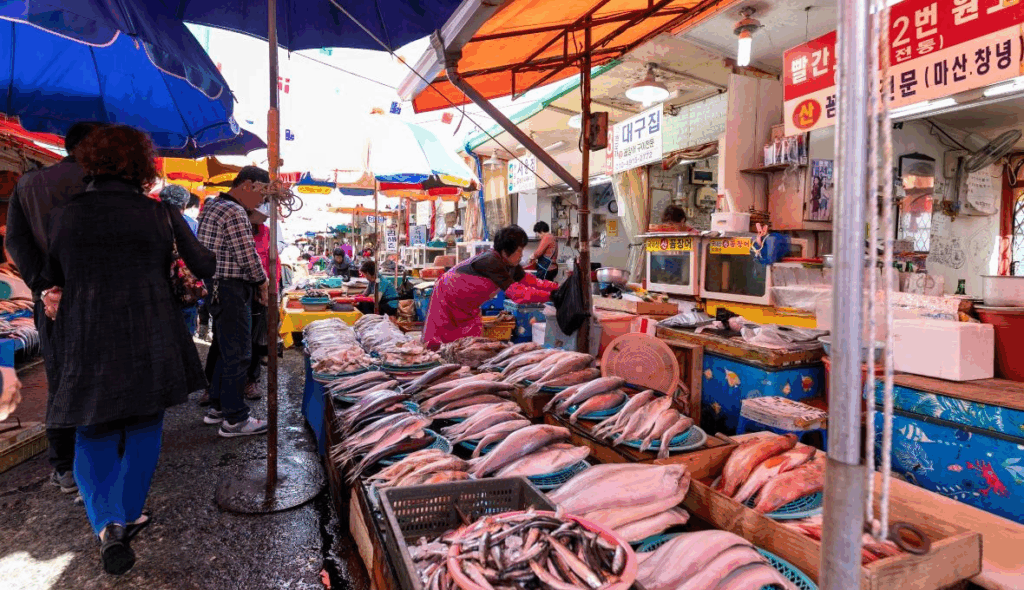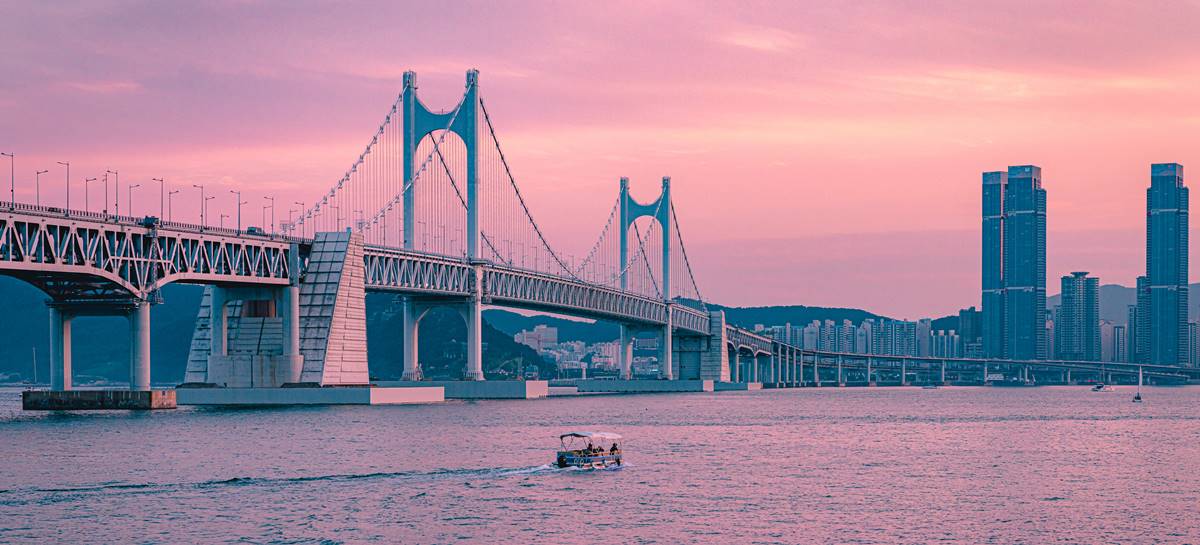Busan is South Korea’s second-largest city and the leading maritime hub of the southeastern region. While famous attractions like Gwangandaegyo Bridge and Haeundae Beach draw countless visitors, it’s the city’s abundant seafood that truly defines Busan’s identity. The easy access to fresh and diverse marine products is a source of great pride for locals. If you’re planning a trip to Busan, make sure to visit one of its vibrant seafood markets to experience the city’s rich sights, sounds, and flavors firsthand. In this post, we’ll explore some of Busan’s most representative seafood markets and what to see and eat at each one.
Jagalchi Market: The Symbol of Busan’s Seafood Scene
When you think of Busan’s seafood markets, Jagalchi Market is undoubtedly the first that comes to mind. As one of Korea’s largest fish markets, it spans a vast area filled with a wide variety of live fish, shellfish, shrimp, octopus, and seaweed. Located near Busan Port, freshly caught seafood arrives at dawn every day, ensuring unmatched freshness and quality.
As you stroll through the market’s bustling aisles, you’ll hear lively “ajimae” (a local term for “aunties” or middle-aged women) cheerfully calling out to customers with great deals. Just walking past the stalls fills the air with the scent of the sea and a sense of liveliness—as if you’re exploring a grand museum of marine life. One of Jagalchi’s unique experiences is purchasing live fish and having it prepared at a nearby restaurant on the spot. You can ask for sliced sashimi or spicy fish stew, allowing you to enjoy a hearty, ultra-fresh seafood meal right there at the market.

Bupyeong Kkangtong Market: From Fusion Seafood to Korean Street Snacks
Busan’s marketplace culture is incredibly rich, with over 20 major traditional markets across the city. Among them, Bupyeong Kkangtong Market stands out not only for its seafood but also for its diverse street foods and merchandise. The name “Kkangtong,” meaning “can,” comes from the market’s postwar history when army goods and canned products were sold here. Today, it’s better known for Busan-style tteokbokki, fish cakes, and seafood skewers that delight both tourists and locals alike.
If your focus is on seafood, head to the market’s seafood street-food section. There, you can easily grab quick bites like boiled octopus, fried squid, or spicy stir-fried baby octopus. It’s the perfect place to enjoy local flavors while exploring the lively market streets. With the mix of the distinctive Busan dialect, cheerful vendors, and energetic atmosphere, visitors can enjoy a truly authentic “local experience.”

Gijang Coast: Seaweed, Kelp, and Coastal Vibes
If you’d like to escape the city center, head toward the coastal towns of Gijang County in northeastern Busan. Gijang has long been famous for its quality seaweed and kelp. As you drive along the shoreline, you’ll find many “Gijang Seaweed & Kelp Direct Sale Stores” where you can browse everything from dried sea vegetables to local sauces and fermented seafood.
Gijang is also renowned for its grilled hagfish, especially along the “Eel Alley,” where smoky aromas fill the air. The chewy yet tender texture combined with the charcoal grill flavor makes it a local favorite. If you’re feeling adventurous, Gijang’s coastal restaurants serve a variety of seafood barbecue dishes that offer a premium yet authentic taste of Busan’s ocean-to-table cuisine.
Gwangalli Fish Market: Modern Vibes and Night Views
When it comes to Busan’s nightlife, Gwangalli stands side by side with Haeundae as a must-visit destination. The illuminated Gwangandaegyo Bridge offers one of the most spectacular night views in Korea, and nearby, you’ll find a few small but charming fish markets. While not as large as Jagalchi, these local markets offer a friendlier atmosphere and more affordable prices.
Around the Gwangalli Beach area, you can buy fresh seafood and enjoy it at the outdoor tables with a cold beer or soju. As the sun sets across the bridge and the sky turns pink, the combination of ocean breeze and fresh sashimi creates an unforgettable moment. It’s a romantic experience for couples and friends alike, and even if you’re traveling solo, you’ll feel a sense of freedom unique to Busan’s coastal charm.
Tips for Enjoying Busan Seafood Markets Like a Local
To make the most of your visit to Busan’s seafood markets, a few local tips can be helpful. First, learn a bit about price negotiation. While large markets usually have fixed rates, small stalls or street vendors may offer flexibility. Rather than pushing too hard on price, it’s best to find trustworthy sellers and agree on a fair deal—it keeps the experience pleasant for both sides.
Another common practice in Busan is to buy seafood at the market and take it to a nearby restaurant, where you pay a small “table fee” or “sauce fee” to have it prepared and served. This charge varies by establishment, and it’s wise to confirm what side dishes and condiments are included beforehand. This way, you can avoid any misunderstandings and fully enjoy your fresh seafood feast.
Beyond Food: The Cultural Charm of Busan’s Markets
It’s easy to think of seafood markets as mere places to buy food, but they’re actually full of cultural significance and local life. Watching the early-morning seafood auctions offers a glimpse into Busan’s economic rhythm, while chatting with friendly fishmongers reveals the city’s warm, down-to-earth character. For many travelers, markets are the best places to experience Busan “like a local.”
Even if you’re unfamiliar with the Busan dialect, a simple smile and the question, “How much is this?” will earn you a friendly response. Sometimes, vendors even throw in a little extra seafood or recommend local specialties. These small interactions often become the most memorable moments of travel—proof that hospitality and flavor go hand in hand in Busan’s markets.
Conclusion: Culinary Memories Framed by the Sea in Busan
Busan truly lives up to its reputation as a “seafood paradise.” At large markets like Jagalchi, you can witness dynamic scenery and taste the freshest catches of the day, while smaller neighborhood markets offer cozy charm and laid-back vibes. Whether you plan a leisurely coastal route through Gijang and Gwangalli or spend a whole day hopping between markets, the experience will fill both your table and your heart.
No matter your itinerary, exploring Busan’s seafood markets will reward you with unique tastes, vivid sights, and heartwarming human connections. The city’s claim of being “a metropolis born by the sea” couldn’t be more fitting, and every visitor leaves with unforgettable impressions. With this guide, we hope you’ll create your own lasting seafood memories in Busan—savoring fresh sashimi while soaking in the deep blue of the ocean itself.

WeBring Service : Provides personalized services to foreigners living in Korea
Exclusive offer: Introducing foreign car rental in Korea, WeBring-SoCar

